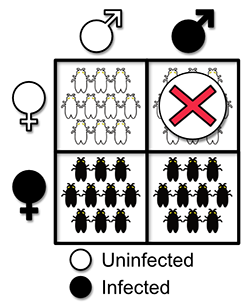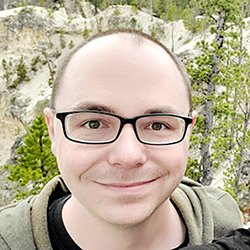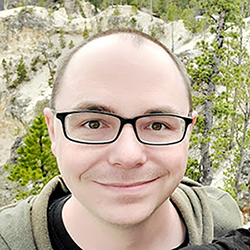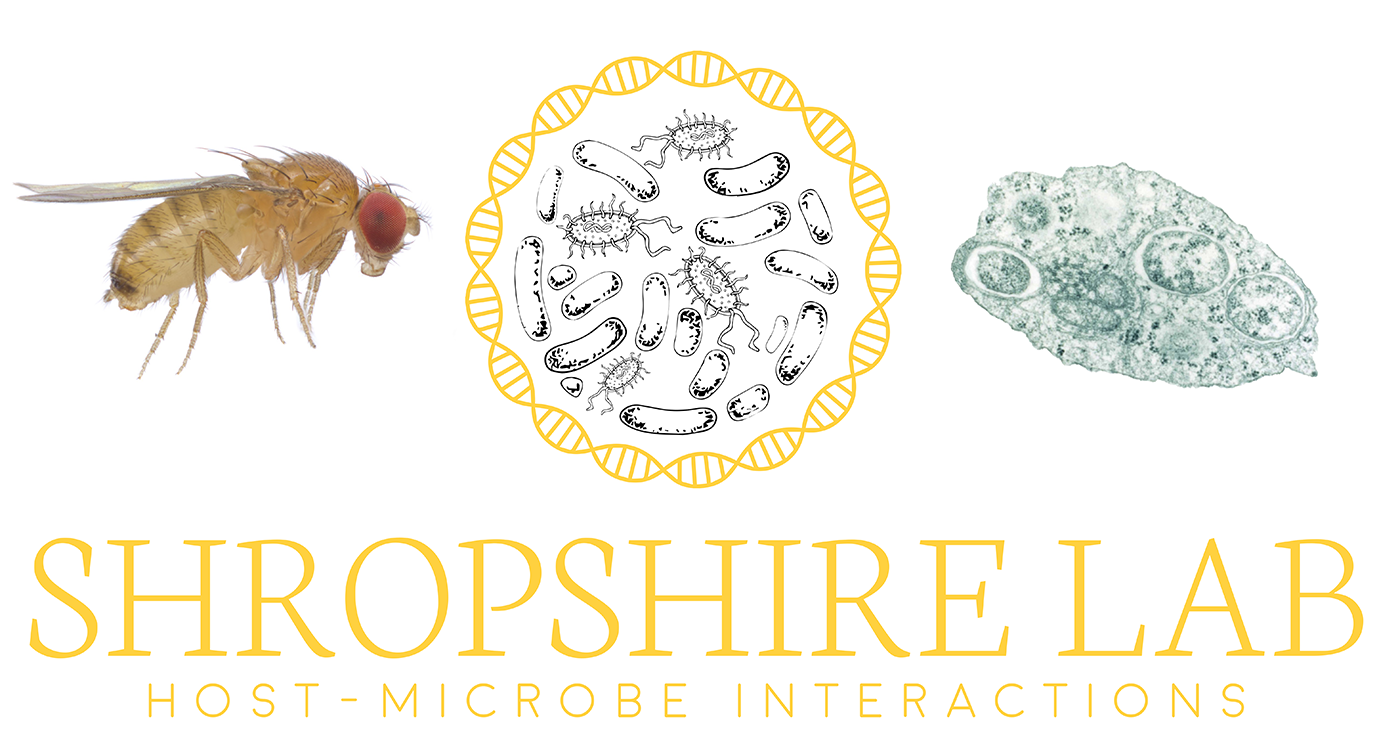 It has become increasingly clear that many animals have close, often intimate, relationships with bacteria and viruses. These associations can have profound impacts on host biology. We are a collaborative research group studying insect-microbe interactions, focusing on endosymbiotic bacteria that live inside host cells. Wolbachia bacteria are the most common known endosymbionts, infecting over half of insect species. My prior work has focused on understanding the genetic, mechanistic, and evolutionary underpinnings of traits that govern Wolbachia's widespread prevalence. Specifically, many Wolbachia manipulate their host's reproduction in several ways to encourage their spread across generations. Among these, cytoplasmic incompatibility (CI) is the most common, causing eggs to die when Wolbachia-bearing males mate with uninfected females. Females with Wolbachia remain compatible (Fig 1). The Shropshire lab aims to deeply understand the genetic, molecular, and mechanistic basis of this powerful bacterial adaptation and Wolbachia's basic biology more broadly. Below, we describe a few areas of specific interest and our recent results.
It has become increasingly clear that many animals have close, often intimate, relationships with bacteria and viruses. These associations can have profound impacts on host biology. We are a collaborative research group studying insect-microbe interactions, focusing on endosymbiotic bacteria that live inside host cells. Wolbachia bacteria are the most common known endosymbionts, infecting over half of insect species. My prior work has focused on understanding the genetic, mechanistic, and evolutionary underpinnings of traits that govern Wolbachia's widespread prevalence. Specifically, many Wolbachia manipulate their host's reproduction in several ways to encourage their spread across generations. Among these, cytoplasmic incompatibility (CI) is the most common, causing eggs to die when Wolbachia-bearing males mate with uninfected females. Females with Wolbachia remain compatible (Fig 1). The Shropshire lab aims to deeply understand the genetic, molecular, and mechanistic basis of this powerful bacterial adaptation and Wolbachia's basic biology more broadly. Below, we describe a few areas of specific interest and our recent results.
What is the genetic basis of bacterial reproductive manipulation?
Strictly maternally transmitted endosymbionts are not often genetically manipulable. This makes them a challenging system for genetic studies linking genotypes to phenotypes. However, 'omic analyses opened the door for investigating associations between gene presence/absence among diverse species and looking for covariance with phenotypes of interest. Using this approach, we determined candidate genes for Wolbachia-induced CI. With collaborators, we tested these genes by leveraging the powerful Drosophila melanogaster model to express Wolbachia genes in flies that did not have Wolbachia (transgenics). We discovered that two genes that we called CI factors A and B (cifA and cifB) caused CI when expressed in testes (LePage et al. 2017 Nature), that cifA expression in females rescued Wolbachia-induced CI (Shropshire et al. 2018 PNAS), and that we could completely recapitulate CI-induced embryonic death and rescue using transgenes alone (Shropshire et al. 2019 PLOS Genetics). The most exciting part? The genes that cause CI and rescue are not technically Wolbachia genes. Instead, they are encoded within Wolbachia's prophage. Thus, viral genes directly control arthropod reproduction.
How do manipulative genes work to modify host biology?
Transgenic work in Drosophila enabled the discovery of the genes that caused CI, but how the proteins contributed to CI remained largely unknown. We used a set of mutagenesis assays to discover numerous amino acids essential for CI and rescue function (Shropshire et al. 2020, PLOS Pathogens). This work revealed that some CifA mutations had comparable impacts on both CI and rescue, suggesting a common mechanism in CifA's role in the two phenotypes. We would then leverage these mutations and recombinant proteins purified from an E. coli expression system to determine that CifA has DNase and RNase activity and CifB has DNase activity (Kaur et al. 2022 BioRxiv). This nuclease function translates to spermatid DNA damage, which may represent one of the earliest CI-associated abnormalities. You can read more about our understanding of Cif protein functions in Shropshire et al. 2020 eLife.
What causes phenotypic diversity of bacterial reproductive manipulation?
The CI proteins are considerably diverse, spanning at least five phylogenetic clades we call Types. Early genetic and mechanistic work focused on the Cif proteins of wMel Wolbachia, which belong to the Type 1 clade. Leveraging transgenic expression assays, we determined that Type 2 Cifs can also contribute to CI-like phenotypes and that divergent Cifs display incompatibilities (Shropshire et al. 2021, Genetics). These results largely supported the hypothesis that CI gene variation would underly variation in Wolbachia-Wolbachia incompatibilities, with some caveats. Additionally, while CI sometimes manifests as complete embryonic death, this is more the exception than the rule. Instead, CI ranges from near insignificant to complete reductions in hatching, varying by host genotype, Wolbachia genotype, and numerous biotic and abiotic factors. For instance, young males (Shropshire et al. 2021, mBio) and males born from older unmated females (Layton et al. Shropshire 2019, mBio) cause stronger CI. The underlying cause of CI strength variation is largely unknown, but we have identified patterns of CI-strength covariance with Wolbachia density and cif-gene expression in the testes.
A complete list of papers is available on Google Scholar.
Co-first Authors#, Undergraduate Author*, Corresponding Author†
Papers published before joining Lehigh University:
2022
Shropshire, J.D., Hamant, E., Conner, W.R., & Cooper, B.S. (2022) cifB transcription largely explains cytoplasmic incompatibility variation across divergent Wolbachia. PNAS Nexus.
Kaur, R.†, Shropshire, J.D., Leigh, B., & Bordenstein, S.R.† (2022) Nuclease proteins CifA and CifB promote spermatid DNA damage associated with symbiont-induced cytoplasmic incompatibility. BioRxiv. Download PDF.
Hague, M.†, Shropshire, J.D., Caldwell, C.N., Statz J.P., Stanek K.A., Conner, W.R., & Cooper, B.S. (2022) Temperature effects on cellular host-microbe interactions explain continent-wide endosymbiont prevalence. Current Biology. Download PDF. Primer by Stuckert & Matute.
2021
Shropshire, J.D.†, Hamant, E.*, & Cooper, B.S. (2021) Male age and Wolbachia dynamics: Determining how fast and why bacterial densities and cytoplasmic incompatibility strengths vary. mBio. Download PDF.
Shropshire, J.D.†, Rosenberg, R.*, & Bordenstein, S.R.† (2021). The impacts on cytoplasmic incompatibility factor (cifA and cifB) genetic variation on phenotypes. Genetics. Download PDF. Journal cover.
Kaur, R.K.†, Shropshire, J.D., Cross, K.L., Leigh, B., Mansueto, A.J., Stewart, V., Bordenstein S.R., and Bordenstein S.R.† (2021). Living in the Endosymbiotic World of Wolbachia: A Centennial Review. Cell Host & Microbe. Download PDF.
2020
Shropshire, J.D.†, Kalra, M.*, & Bordenstein, S.R.† (2020). Evolution-guided mutagenesis of the cytoplasmic incompatibility proteins: Identifying CifA’s complex functional repertoire and new essential regions in CifB. PLOS Pathogens. Download PDF.
Pugazenthi, S.*, White, P.*, Basu, A.*, Chandrashekar, A.*, & Shropshire, J.D.† (2020). Survey of Wolbachia prevalence in Nashville, Tennessee reveals novel infections. American Journal of Undergraduate Research. Download PDF.
Shropshire, J. D.†, Leigh, B., & Bordenstein, S. R.† (2020). Symbiont-mediated cytoplasmic incompatibility: what have we learned in 50 years? eLife. Download PDF.
2019
Layton, E.M.*, On, J.*, Perlmutter, J., & Bordenstein, S.R.† & Shropshire, J.D. † (2019). Paternal grandmother age affects the strength of Wolbachia-induced cytoplasmic incompatibility in Drosophila melanogaster. mBio. Download PDF.
Shropshire, J. D.†, & Bordenstein, S. R.† (2019). Two-By-One model of cytoplasmic incompatibility: Synthetic recapitulation by transgenic expression of cifA and cifB in Drosophila. PLOS Genetics. Download PDF.
Shropshire, J. D.†, Leigh, B., Bordenstein, S. R., Duplouy, A., Riegler, M., Brownlie, J. C., & Bordenstein, S. R.† (2019). Models and Nomenclature for Cytoplasmic Incompatibility: Caution over Premature Conclusions-A Response to Beckmann et al. Trends in genetics: TIG. Download PDF.
2018
Shropshire, J. D.†, On, J.*, Layton, E. M.*, Zhou, H.*, & Bordenstein, S. R.† (2018). One prophage WO gene rescues cytoplasmic incompatibility in Drosophila melanogaster. Proceedings of the National Academy of Sciences. Download PDF. In the news.
2017
LePage, D. P. #, Metcalf, J. A. #, Bordenstein, S. R., On, J.*, Perlmutter, J. I., Shropshire, J. D., Layton, E.M.*, Funkhouser-Jones, L. J., Beckmann, J.F., & Bordenstein, S. R.† (2017). Prophage WO genes recapitulate and enhance Wolbachia-induced cytoplasmic incompatibility. Nature. Download PDF. In the news.
Shropshire, J. D. & A. Rokas† (2017). Heredity: The gene family that cheats Mendel. eLife. Download PDF.
2016
Shropshire, J. D. †,#, van Opstal, E. J.#, & Bordenstein, S. R. † (2016). An optimized approach to germ-free rearing in the jewel wasp Nasonia. PeerJ. Download PDF.
Dittmer, J., van Opstal, E. J., Shropshire, J. D., Bordenstein, S. R., Hurst, G. D., & Brucker, R. M.† (2016). Disentangling a holobiont–recent advances and perspectives in Nasonia wasps. Frontiers in Microbiology. Download PDF.
Shropshire, J. D.†, & Bordenstein, S. R.† (2016). Speciation by symbiosis: The microbiome and behavior. mBio. Download PDF.
2015
Shropshire, J.D., Moore, D., Seier, E., & Joplin, K. H.† (2015). Male aggression, limited female choice and the ontogeny of mating behaviour in the flesh fly Sarcophaga crassipalpis. Physiological Entomology. Download PDF.
2014
Moore, D., Paquette, C., Shropshire, J. D., Seier, E., & Joplin, K. H.† (2014). Extensive reorganization of behavior accompanies ontogeny of aggression in male flesh flies. PLOS One. Download PDF.
Lab Members
Dylan Shropshire
 Assistant Professor (2023-)
Assistant Professor (2023-)
I am a geneticist of host-microbe interactions. I did my postdoctoral work as an NSF postdoctoral fellow at the University of Montana with Prof. Brandon Cooper and received my PhD as an NSF graduate research fellow at Vanderbilt University with Prof. Seth Bordenstein. My research has focused on understanding the mechanisms and diversity of bacterial manipulations of insect reproduction, with Wolbachia bacteria as a model. In addition to my passion for research, I am deeply passionate about mentorship and education.
Email — Google Scholar — LinkedIn — Twitter
YOU!
There will often be opportunities in the lab for new postdoctoral scholars, technicians, graduate students, and undergraduates.
Please take a look at the "Openings" page for more information on how to get involved!
Job Opportunities
The Shropshire Lab is often hiring graduate students, postdoctoral researchers, and technicians. Please visit https://lehigh.edu/shropshirelab/openings to see current job opportunities and how to apply. Positions are almost always available for undergraduate students, and there are many ways to get involved. Volunteer and federal work-study positions are the most common entry-level roles. Students demonstrating dedication to their research experience may have opportunities to be paid as part-time technicians or receive course credit for research contributions. The lab will also support students interested in the departmental honors program or the Rapidly Accelerated Research Experience (RARE) program.
Reach out to Dr. Shropshire via email if you're an undergraduate interested in joining the lab. Your email should include a brief description of your interests in the lab, CV, and unofficial transcripts.



